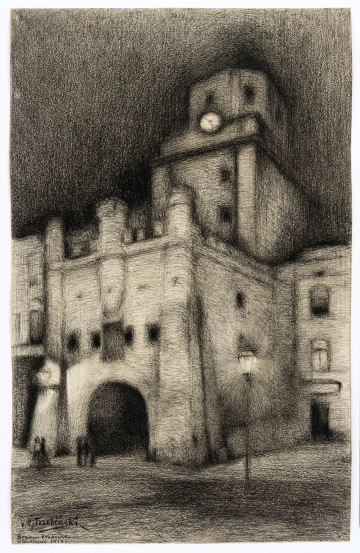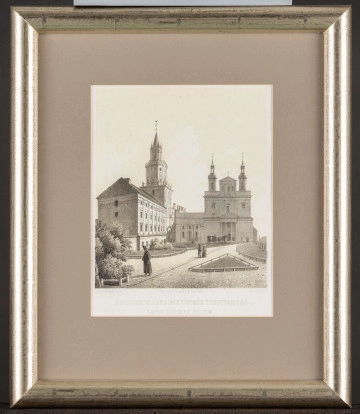
Lublin Cathedral
1880 — 1900
National Museum in Lublin
Part of the collection: Lubliniana. Painting views of Lublin and the Lublin Region
Konstanty Kietlicz-Rayski (1868–1924) studied at the School of Fine Arts in Krakow, then in Warsaw, in the drawing class of the eminent painter Wojciech Gerson, and in the studio of Leon Wyczółkowski. In the first decades of the 20th century, he was one of the most active animators of Lublin's artistic life. He was a painter and ethnographer - the author of numerous studies of the folk types of the Lublin and Podhale regions, he was engaged in journalistic activity, he played in the theatre as an amateur. His work falls within the traditional current of art, which, according to Kietlicz, should be primarily understandable to the recipient. It was dominated by atmospheric watercolours and ink-washed landscapes and views of picturesque corners of Lublin, with which the artist connected his life after 1904.
Kietlicz's drawing shows the bridge over Bystrzyca at Zamojska Street in a wider perspective, with the towers of the cathedral and two Lublin gates - Trinitarian and Krakowska gates visible in the distance. The bridge, erected in 1909 using the pre-stressed concrete method, is one of the oldest reinforced concrete bridges in south-eastern Poland. It was built on the site of the former wooden bridge on the Bychawa and Uściługsko-Zamojski routes, leading south from Lublin. In 2012, it was named after the designer, Marian Lutosławski - engineer, inventor and social activist, author of the second Lublin bridge erected in 1908 in the Kalinowszczyzna region. Both structures, built in the technology invented by François Hennebique, on driven reinforced concrete piles, are among the only surviving bridges of this type in Europe. The neo-Gothic architectural costume was designed by Jan Heurich the Younger, following the example of the Saint Severin church in Paris. The Warsaw architect gave the concrete balustrades the form of openwork tracery with pillars topped with pinnacles in the shape of cones. The bridge was lit by lanterns placed on monumental vaults accentuating the extreme spans. Its erection was documented on a cast-iron plaque stored in the Museum of the History of the City of Lublin: "Most żelazno-betonowy systemu Hennebique’a zbudowany przez inżyniera M. Lutosławskiego [The Iron-Concrete Bridge of the Hennebique System Built by Engineer M. Lutosławski], Warsaw, Bohema 1".
Anna Hałata
Author / creator
Dimensions
cały obiekt: height: 26 cm, width: 15,5 cm
Object type
painting
Technique
aquarel
Material
cardboard
Creation time / dating
Creation / finding place
Owner
The National Museum in Lublin
Identification number
Location / status

Stepanov
1880 — 1900
National Museum in Lublin

Trzebiński, Marian
1910
National Museum in Lublin

Cegliński, Julian
1857
National Museum in Lublin
DISCOVER this TOPIC
Museum of King Jan III's Palace at Wilanów
DISCOVER this PATH
Educational path
0/500

We use cookies to make it easier for you to use our website and for statistical purposes. You can manage cookies by changing the settings of your web browser. More information in the Privacy Policy.
We use cookies to make it easier for you to use our website and for statistical purposes. You can manage cookies by changing the settings of your web browser. More information in the Privacy Policy.
Manage cookies:
This type of cookies is necessary for the website to function. You can change your browser settings to block them, but then the website will not work properly.
WYMAGANE
They are used to measure user engagement and generate statistics about the website to better understand how it is used. If you block this type of cookies, we will not be able to collect information about the use of the website and we will not be able to monitor its performance.